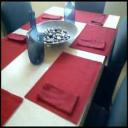Yahoo Answers is shutting down on May 4th, 2021 (Eastern Time) and the Yahoo Answers website is now in read-only mode. There will be no changes to other Yahoo properties or services, or your Yahoo account. You can find more information about the Yahoo Answers shutdown and how to download your data on this help page.
Trending News
Chemistry chemistry concerning moles?
I got this question wrong on an exam and I need clarification as to why I got it wrong.
A student spilled 100.0 ml of 6.00M HCL (aq) on the work bench and tried to neutralize it with 0.125 L of 4.00M NaHCO3 (aq).
Will that be enough to get rid of all the acid? Why or why not?
As for my calculations, I did (6M HCL/100 mL) * (1000 mL/1 L) to find the molarity of HCL.
I did (4M NaHCO3/.125 L) * 1 L to find the molarity of NaHCO3.
In the end, my explanation was that even though the student is using more volume to clean up the HCL spill, it contains a smaller molarity than the 100 mL of 6.00 M HCL, so it would not be enough to get rid of the acid.
Any answer is appreciated.
1 Answer
- Simonizer1218Lv 78 years agoFavorite Answer
moles of HCl = 0.1 L x 6 mol/L = 0.6 moles HCl
moles NaHCO3 = 0.125 L x 4 mol/L = 0.5 moles NaHCO3
According to the balanced equation of HCl + NaHCO3 --> NaCl + CO2 + H2O it takes 1 moles NaHCO3 to neutralize 1 moles HCl. You don't have enough NaHCO3 (0.5 moles) to neutralize all HCl (0.6 moles).
NOTE: It is the number of MOLES and not the MOLARITY that matters. In your answer, you use the term molarity, which is incorrect.


